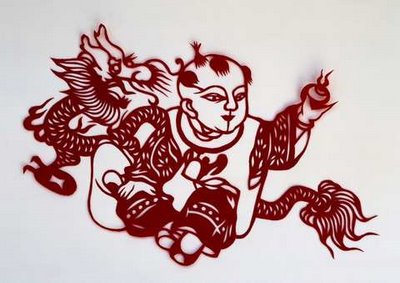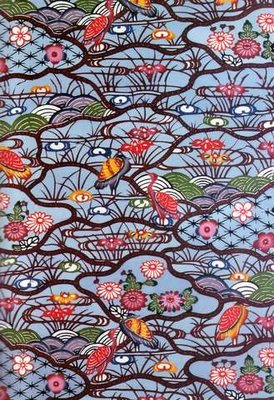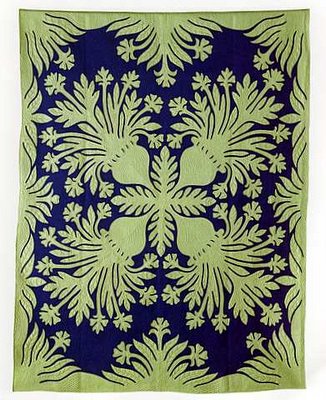 I have a fascination with folkart, perhaps because the best of it contains just enough perfection and just enough humanity.
I have a fascination with folkart, perhaps because the best of it contains just enough perfection and just enough humanity.Let me show you some beautiful examples of the folkart of papercutting. Papercutting originated in China (paper was invented in China). Instances of papercutting in China can be traced to the Northern and Southern Dynasties period (A.D. 386-581). Later, in the T'ang Dynasty (A.D. 618-906) references to papercuts can found in a poem by the poet Ts'ui Tao-yung. Other sources from this period describe papercuts being worn as hair ornaments by ladies in form of flowers and butterflies.
Above is an example of a Chinese paper cut using red paper. Chinese papercuts can also be white paper that has been coloured with ink to create full colour effects. This image is from wikipedia's Chinese papercut page which has lots of good information about the Chinese paper cutting tradition.

Japan uses the art of papercutting not as festive decoration but as a method used in dying fabric. These papercuts are often extremely elaborate and the pieces are reinforced with hair or thread fine enough not to be seen once the printing has occurred. The picture below has been decorated using this method known as Bingata; these colourful cloths originated in the warmer climate of Okinawa in the 14th century.

These pictures have come from the books: Japanese Floral Stencil Designs and Dyeing Originated in Okinawa: Bingata (Japanese Designs and patterns, Mitsumura Suiko Shoin, ISBN 483810104x.

Scherenschnitte (pronounced shear-n-SNIT- a) is the Swiss name for papercutting and they have a rich tradition of their own. While mainly know for its black paper silhouette many fine examples of Swiss scherenschnitte exists that use coloured papers in layers as well. Above is a heavily worked piece capturing aspects of village life and symbols of love by Johann-Jakob Hauswirth (1808-1871). The image above comes from the book: Paper Cuts by Jakob Hauswirth and Louis-David Saugy, Charles Apotheloz, Thames and Hudson, 1980 ISBN 0500271704.

Polish paper cutting is called wycinanki (pronounced vee-chee-non-kee) and has two types: the bold, black symmetrical style called Kurpie (coor-pye) originating in the Kurpie district of Poland; and the layered paper style that features animals and people from the Lowicz (wo-vitz) district which is shown above. For a quick look at some more examples of Lowicz papercut designs click here, and for a neat little article on the history of Wycinanki: Then and Now from University at Buffalo State University of New York is quite good. The image above comes from the book: Traditional Papercutting: The Art of Scherenschnitte

The distinctive designs of Hawaiian quilts (example above) are based upon papercuts of the lush sub-tropical Hawaiian flora. This quilt was designed by Kathy Nakajima and was appliqued and quilted by Studio K , 2000 (dimensions 109" x 84"). I loved the way Kathy Nakajima describes her inspiration for the quilt:
"The Queen Emma Summer Palace is my favourite place to visit when I'm one the island of O'ahu. Near the entrance, I always see Hawaiian flowers blossoming in a vase. From the windows comes the cool, soothing wind that always takes me, momentarily, to another world. The colours of this quilt are the colours of the wind at the palace. And the pattern is the flowers that are blossoming in the vase."
The applique technique using papercuts for designing can also be seen in the American Baltimore quilt style. The quilt and quotation above comes from the book: Hawaiian Quilts: Tradition and Transition, Reiko Mochinaga Brandon and Loretta G. H. Woodard, University of Hawaii Press, 2005, ISBN 082482928x, page 125.

Papercutting was recently taken up by some British artists; this website of Mister Rob Ryan was passed along to me by Rebecca the Wrecker. Above is an example of his very fine work called "Rise Above It", 2004.
This is hardly a comprehesive look at papercuts but if I do find some good images of the Mexican Papeles Picado and white lace-cutwork I'll do Papercuts of The World - Part 2.
Tags:

25 comments:
These are BEWTIFUL! No wonder you love them.
A wonderful collection of inages and a great post about a fascinating subject. Well written, Florence.
The papercuts I usually have are those that nick my finger!
O.K I really didn't read this post as I was too distracted and BLOWN AWAY by your amazing header!
beautiful amazing pictures.
i have to read this when i'm awake tomorrow. i read "papercuts" like the painful kind.
nighty night
Rob Ryans work makes my heart sing. But you should also take a look at australian based Emma Van Leest - her work is beautiful (check out the westspace gallery site for more)
always interesting stuff on your blog Florence ,please do part two
wow fabulous!!!!
If I was that good at cutting up stuff my medieval costumes would look so much better!
hugs and more!!!
merly
xxxxxxxxxxxxxxxs
ooooooooooooooos
This is one of my favourite blog entries ever! I love Rob Ryans work and so does Trev
Thank you!
I'm glad to find myself not alone in the appreciation of these lovely creations.
It is unfortunate, that I only have so much time to write these posts, (it takes long enough to prepare the pictures!). But I always come across lots more interesting things after I post and I wish I had included them.
One such gem is that Johann-Jacob Hauswirth was a person of legend himself. He was said to be a giant, a charcoal-burner who lived in the woods. He would come to town infrequently and sold his papercuts. He was said to have had enomous hands and had to devise wire loops that attached to his sissors so that he could use them to make his art. He was known to swap papercuts with the childern in exchange for their bright coloured lolly wrappers. He was known only to have spoken once, elsewise he would have been thought a mute.
I wish I could show you all the beautiful pictures in this book, the very reduced scan of the papaercut by Johann-Jakob in this post doesn't do it justice.
Ramona, Thankyou for introducing me to Emma Van Leest's work her white work is indeed very fine. I'm looking forward to when her website is finished.
Liana, thanks for the thumbs-up for the new look for WindbagandT.
to all xxxs and ooox (especial for you Merly!)
huge hugs back!!!!
I read a text recently; "Eisenstein on Disney" and from it, looking at these papercuts, i am led to observe that what makes them so special , besides the nimble skill required, is that like many kinds of folk art and craft, there is a sensuality that is 'plasmatic', a coming into being of forms from a 'substance'.
...lovely papercuts to say the least.
Shango
Shango, well said. Its difficult to put it into words isn't it. I'm still searching to articulate it adequately myself.
xx
So well considered and researched florence. I love the image of the people on the giant bird - reminded me of my fave children's book, badjelly the witch by spike milligan. the children escaped on the back of jim the giant eagle before badjelly could make them into boy-girl soup.
Miss Wrecker, Its becoming clear to me that your delightfully quick wit had its foundation in the overflowing creative cup of Spike Milligan. Perhaps we might see some exploration of this wellspring in your future projects? I hope so :D
Florence, talking of Spike Milligan, did you know a famous quote of his, that he wanted to put on his gravestone:
"I told you I was ill."
Florence loving it! I have recently purchased Jan Pienkowski's (of Meg and Mog fame)"The Fairy Tales" illustraitions based on paer cuts with Marbled backgrounds reminded me of a fairy tale book seen as a child that I wish I had...soo fine and detailed
Jude? :)
I use to have Meg and Mog !!! Mum and I loved it.
"The Fairy Tales" sounds like a great book too. I wish I could see the illustrations. I'll have to kept my eye out for it next time I'm bookshopping.
Lovely to have you here.
xx
not jude :(
jzti! have we met CQ? via Kylie the ceramicist. hundertwasser fan from way back check out jewish folk style artist Devi Tuszynski
oh!sorry Jzti :P
great to have your drop by the old Windbag :)
I will definitely check out Devi Tuszynski. Could be more good stuff for "Paper Cuts of the World - Part 2"
Kylie J is a friend of mine, check out our new blog http://umbrellacollective.blogspot.com
We have just started a group blog to promote of work as we are preparing a Christmas show on 25th November...stay tuned for more info :)
and love to have you here ;)
xx
Here is another link site:
www.main.nc.us/openstudio/MHGrabman for scherenschnitte with an American twist.
Thank you for the new link :)
xx
wonderful papercutting summary! a few papercut artists that I hadn't seen before...amazing! check out my papercuts too if you'd like:
http://bittystarr.etsy.com
xoxo
bitty
and more papercutting links at http://www.beatricecoron.com/links.htm
VIEW MY PAPERCUTS AT ETSY AND FINE ART AMERICA. WWW.FINEARTAMERICA.COM
NANCY MICHALAK
Hi Florence,
I know it's ages since you wrote this post, but I was just writing a post on my own blog on papercutting and came across you when I Googled. Really enjoyed your article, and your Etsy shop is amazing!
Post a Comment